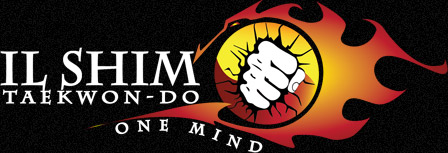IL Shim Tournament Rules
SPARRING
SAFETY EQUIPMENT
COMPULSORY safety equipment for sparring events:
• Dipped foam sparring gloves and boots or the ITF approved sparring equipment
• Mouth guard
• Groin guard for boys
• Head guard (Compulsory for all competitors)
BOUT TIMES
Please note – all divisions are determined by the number of entrants.
COLOUR BELTS & SENIOR BLACK BELTS
2 x 1 ½ minute rounds with 30 seconds break. In the case of a draw, an additional 1 minute round will be
played. In the case of a second draw, the first to score rule will apply in the next round.
ITF POINT SCORING
Points will only be awarded if balance is maintained during and on completion of the attack. Points are
only scored if contact is made to the front of the body, not the back.
One point: Hand attack directed to mid or high section.
Two points: Foot attack to mid section.
Three points: Foot attack to high section.
WARNINGS: – Attack to an illegal target – Falling down whether intentionally or not – Holding/grabbing/pushing or sweeping – Stepping with both feet outside the ring – Pretending to score a point by raising arm – Talking Back – Coach Talking Back – Faking a blow, pretending to be injured – Blind technique (eg spinning back fist if not sighted)
3 Warnings = 1 Deduction point.
FOULS: – Loss of temper – Biting, scratching, clawing opponent – Insulting opponent in anyway – Excessive contact – Attacking with illegal tool (eg Knee, elbow, forehand) – Attacking a fallen opponent
1 Foul = 1 Deduction point.
3 Fouls = Disqualificatio
DISQUALIFICATION: – Misconduct towards referee – Excessive aggressive contact – Infringement of sportsmanship – Infringement of any safety regulation – If suspected of being under the influence of drugs or alcohol – Committing 3 fouls
INDIVIDUAL PATTERNS
1 optional (your choice) and 1 designated (judge’s choice) pattern.
SPECIAL TECHNIQUE
Divisions to be determined by who has entered! Please see the Tournament draw when available.
POWER BREAKING
Division to be determined by who has entered! Please see the Tournament draw when available.
DISPUTE PROCEEDURE.
Section 7 as per ITF revised tournament rules 25-04-2004. Article 54-57. Protest fee of $50 applies.
International Rules and Regulations
- ITF World Junior & Senior Tournament Rules
a. Index (39 kB) (November 29th 2005)
b. Ammendement (47 kB) (November 29th 2005)
c. Ammendement 1 (63 kB) (April 24th 2006)
d. World Junior and Senior Tournament Rules & Regulations (172 kB) (April 24th 2006) - ITF Umpire Rules
a. Index (21 kB) (November 29th 2005)
b. Rules & Regulations (90 kB) (April 24th 2006) - ITF Tournament Forms
a. Index (122 kB) (November 29th 2005)
b. ITF Tournament Forms number 1 to 17 (91 kB) (ammended – April 19th 2006)
These rules, regulations and forms are applied from January 1st 2006.
ITF WORLD CUP Rules and Regulations
- ITF World Cup Tournament Rules – Index (35 kB) (November 29th 2005)
- ITF World Cup Tournament Rules – Rules & Regulations (131 kB) (April 24th 2006)
These World Cup rules and regulations are applied from January 1st 2006
Yours in Taekwon-Do
Master Willem Jacob Bos
ITF Chairman of Tournament & Umpire Committe
I.T.F Jury President Manual
- Jury President Manual (244 kB)
- Center Referee Manual (1.32 MB – 5 pages) (updated)
- Corner Referee Manual (212 kB)
Why do we have ITF-sanctioned tournaments?
- to determine the winner of each championship title
- to encourage the development of lasting friendships among Taekwon-Do practitioners
- to promote technical improvement
The Junior and Senior World Championships are held every two years in the odd-numbered years.
To compete in World Championships, participants must hold an ITF Black Belt degree certificate. They must be national champions in their own countries or be chosen by trial. Each member country National Association names a delegation of competitors and others who will represent that country at the championship tournament.
The World Cup, an open competition, is held every two years in the even-numbered years.
The World Cup competition is open to blue, red and black belts.
Any school, club and/or individual who is not part of the ITF must have permission from the National Association to take part in the World Cup. Any club, school, individual or country may participate with as many individual and/or team members in the same division and or category.
The choice of location and dates of each World Championship and World Cup competition is made by the ITF Congress meeting from the list of qualified candidates submitted by the Tournament & Umpire Committee, which coordinates the calendar of events to avoid scheduling conflicts.
Each Continental Federation determines the frequency of its Continental Championships, which must receive the sanction of the ITF Tournament & Umpire Committee. Continental Federations choose the dates and location of continental and regional competitions, which also must receive ITF sanction.
ITF Tournament and Umpire rules are applied in all competitions.
The ITF strives to provide top quality competition and organization at all its tournaments. Safety is a priority, as is efficient and fair umpiring. Participants are expected to demonstrate sportsmanship and reflect the true spirit of ITF Taekwon-Do at all times.




